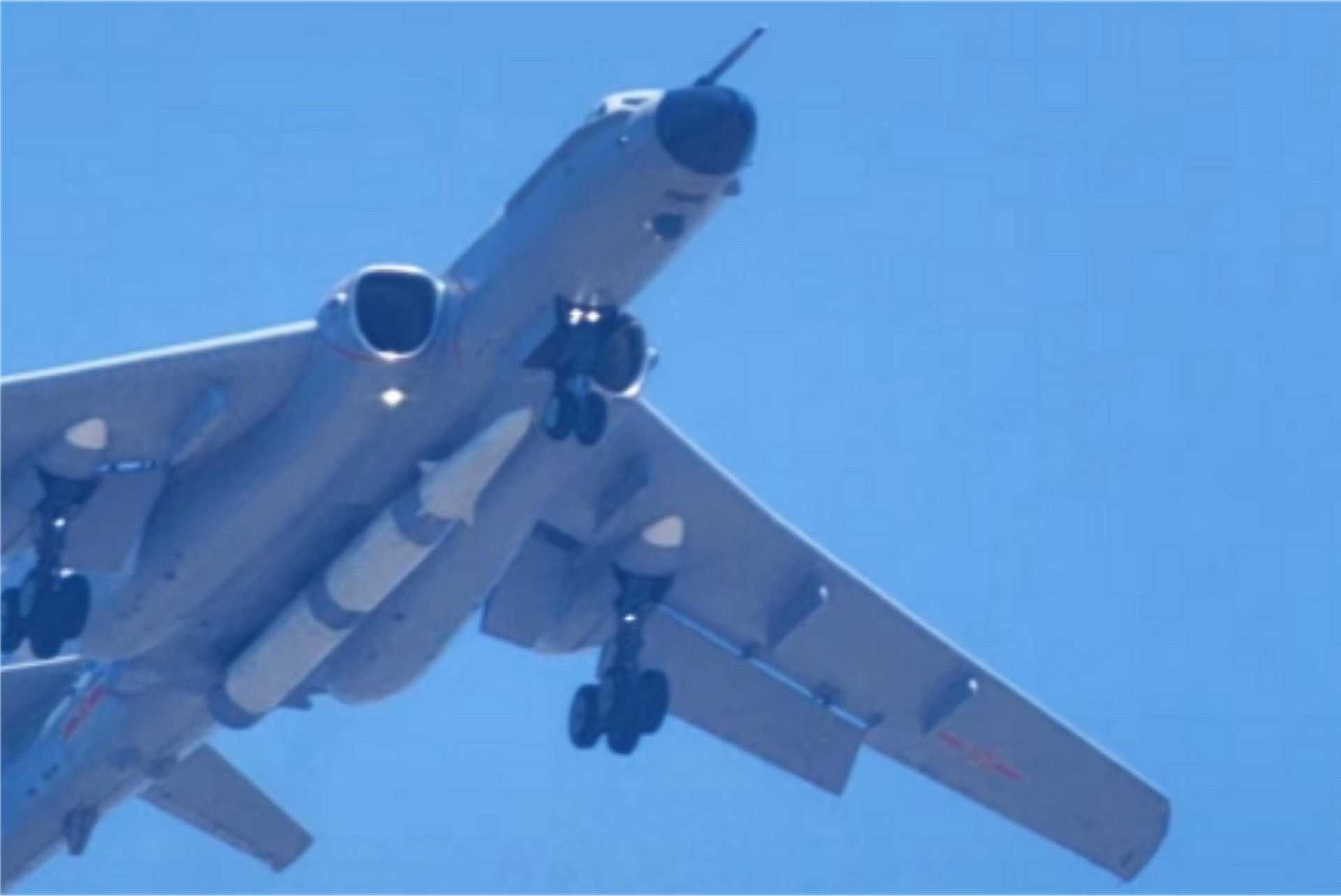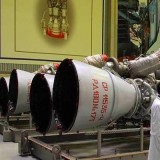Exclusive: China to Boost Air-Launched Ballistic Missile Capabilities with H-6N Bombers Carrying CH-AS-X-13

{loadposition bannertop}
Breaking news
{loadposition sidebarpub}
On April 6, 2025, new imagery released by defense analyst Vivek Singh on his X account has offered a rare and revealing look into one of the most advanced strike capabilities currently in development within the Chinese military arsenal. The images depict a Chinese Xi’an H-6N strategic bomber in flight, carrying an air-launched ballistic missile (ALBM) under its fuselage, identified by NATO as the CH-AS-X-13. This missile is widely believed to be an air-launched variant of the DF-21 medium-range ballistic missile (MRBM), marking a major leap forward in China’s aerial long-range strike capabilities.Follow Army Recognition on Google News at this link
google_ad_client = “pub-4068738923530102”;
/* 468×15 data sheet menu top dark green */
google_ad_slot = “3500417247”;
google_ad_width = 468;
google_ad_height = 15;
// ]]>
google_ad_client = “pub-4068738923530102”;
/* top_468x60_fiche_technique */
google_ad_slot = “2746785843”;
google_ad_width = 468;
google_ad_height = 60;
// ]]>
A Chinese H-6N bomber is seen in flight carrying the CH-AS-X-13 air-launched ballistic missile, showcasing a major leap in China’s strategic long-range strike capabilities. (Picture source: Vivek Singh X account)
From a technological standpoint, the CH-AS-X-13—or KF-21, as it may be designated within China—is a two-stage, solid-fueled ballistic missile specifically engineered for deployment from high-altitude bomber platforms. With an estimated operational range of approximately 3,000 km, this system grants the People’s Liberation Army Air Force (PLAAF) the capacity to strike strategic targets far beyond the immediate combat theater. The missile is reportedly capable of carrying either a conventional or nuclear warhead, and potentially features a maneuverable reentry vehicle (MaRV), enabling it to evade modern missile defense systems and strike moving or fortified targets with high precision.
Unlike cruise missiles, which travel at subsonic or low-supersonic speeds, the CH-AS-X-13 is expected to reach hypersonic speeds during its ballistic trajectory, possibly exceeding Mach 6. This velocity, coupled with a depressed trajectory and mid-course maneuverability, severely limits the response time for enemy air defense systems. Furthermore, if equipped with terminal guidance systems—such as active radar or infrared seekers—the missile could serve as a potent anti-ship weapon capable of targeting aircraft carriers and other high-value maritime assets, reinforcing China’s anti-access/area denial (A2/AD) doctrine.
Enabling this advanced strike capability is the Xi’an H-6N bomber, the most modern and heavily modified iteration of the H-6 bomber family, itself a derivative of the Soviet Tu-16. Unlike the earlier H-6K, the H-6N features a recessed weapons bay and a semi-conformal fuselage mount specifically engineered to carry oversized payloads such as the CH-AS-X-13. This structural modification allows the bomber to transport large ALBMs without compromising aerodynamic stability.
The H-6N is powered by twin D-30KP-2 turbofan engines, providing an estimated top speed of Mach 0.75 and a combat radius of over 3,500 km without aerial refueling. Crucially, the platform is equipped with an in-flight refueling probe, significantly expanding its operational range and enabling missions well beyond the First Island Chain. Its avionics suite likely includes a modernized glass cockpit, integrated digital fire-control systems, and long-range navigation aids to support precision engagement of strategic targets.
With a maximum payload capacity exceeding 20,000 kg, the H-6N can carry a variety of standoff weapons in addition to ballistic missiles, including cruise missiles, precision-guided munitions, and electronic warfare pods. This versatility makes the bomber a key component of China’s developing nuclear triad and a credible deterrent in both regional and strategic theaters.
When combined, the CH-AS-X-13 and H-6N form a highly flexible and survivable strike system that poses a formidable challenge to regional air and naval forces. The bomber’s extended reach and survivability, when paired with the speed, range, and accuracy of the ALBM, allow the PLAAF to conduct preemptive or retaliatory strikes against hardened, time-sensitive, or mobile targets deep within enemy territory or at sea.
The CH-AS-X-13 air-launched ballistic missile, seen mounted on a Chinese H-6N bomber, poses a significant threat within a 3,000 km radius—placing U.S. bases, allied naval forces, and strategic assets across the Indo-Pacific well within its strike range. (Picture source: Editing Army Recognition Group)
This development is not merely a technological milestone but a transformative shift in strategic airpower for China. The integration of an air-launched ballistic missile with a long-range bomber platform gives the PLA a highly effective tool for power projection and strategic deterrence, particularly within contested regions like the South China Sea, Taiwan Strait, and potentially the Indian Ocean.
Strategically, this capability has far-reaching implications for the United States and its allies. The CH-AS-X-13 poses a direct threat to U.S. carrier strike groups operating in the Pacific, with the potential to undermine key elements of American naval superiority. Its hypersonic speed and potential maneuverability drastically reduce reaction time, challenging even the most advanced naval missile defense systems.
Moreover, the use of the H-6N as a launch platform means these missiles can be deployed rapidly from unpredictable locations, bypassing static missile defense networks and expanding China’s second-strike options. The CH-AS-X-13, with its nuclear-capable profile, reinforces China’s strategic deterrence posture and may serve as a key component of its evolving nuclear triad, altering the balance of power and deterrence calculations in the Indo-Pacific.
This evolution of China’s strike capability further complicates the U.S. military’s forward-deployed operations and force projection. Washington may need to accelerate developing and deploying advanced missile defense systems, dispersal strategies for naval forces, and hardened facilities in Guam, Japan, and potentially Australia.
The operational appearance of the CH-AS-X-13 aboard the H-6N reflects a decisive shift in China’s ability to wage long-range precision warfare. It signals a transition toward a more flexible, mobile, and unpredictable missile doctrine that will shape the strategic calculus of the United States and its allies for years to come.

{loadposition bannertop}
Breaking news
{loadposition sidebarpub}
On April 6, 2025, new imagery released by defense analyst Vivek Singh on his X account has offered a rare and revealing look into one of the most advanced strike capabilities currently in development within the Chinese military arsenal. The images depict a Chinese Xi’an H-6N strategic bomber in flight, carrying an air-launched ballistic missile (ALBM) under its fuselage, identified by NATO as the CH-AS-X-13. This missile is widely believed to be an air-launched variant of the DF-21 medium-range ballistic missile (MRBM), marking a major leap forward in China’s aerial long-range strike capabilities.
Follow Army Recognition on Google News at this link
A Chinese H-6N bomber is seen in flight carrying the CH-AS-X-13 air-launched ballistic missile, showcasing a major leap in China’s strategic long-range strike capabilities. (Picture source: Vivek Singh X account)
From a technological standpoint, the CH-AS-X-13—or KF-21, as it may be designated within China—is a two-stage, solid-fueled ballistic missile specifically engineered for deployment from high-altitude bomber platforms. With an estimated operational range of approximately 3,000 km, this system grants the People’s Liberation Army Air Force (PLAAF) the capacity to strike strategic targets far beyond the immediate combat theater. The missile is reportedly capable of carrying either a conventional or nuclear warhead, and potentially features a maneuverable reentry vehicle (MaRV), enabling it to evade modern missile defense systems and strike moving or fortified targets with high precision.
Unlike cruise missiles, which travel at subsonic or low-supersonic speeds, the CH-AS-X-13 is expected to reach hypersonic speeds during its ballistic trajectory, possibly exceeding Mach 6. This velocity, coupled with a depressed trajectory and mid-course maneuverability, severely limits the response time for enemy air defense systems. Furthermore, if equipped with terminal guidance systems—such as active radar or infrared seekers—the missile could serve as a potent anti-ship weapon capable of targeting aircraft carriers and other high-value maritime assets, reinforcing China’s anti-access/area denial (A2/AD) doctrine.
Enabling this advanced strike capability is the Xi’an H-6N bomber, the most modern and heavily modified iteration of the H-6 bomber family, itself a derivative of the Soviet Tu-16. Unlike the earlier H-6K, the H-6N features a recessed weapons bay and a semi-conformal fuselage mount specifically engineered to carry oversized payloads such as the CH-AS-X-13. This structural modification allows the bomber to transport large ALBMs without compromising aerodynamic stability.
The H-6N is powered by twin D-30KP-2 turbofan engines, providing an estimated top speed of Mach 0.75 and a combat radius of over 3,500 km without aerial refueling. Crucially, the platform is equipped with an in-flight refueling probe, significantly expanding its operational range and enabling missions well beyond the First Island Chain. Its avionics suite likely includes a modernized glass cockpit, integrated digital fire-control systems, and long-range navigation aids to support precision engagement of strategic targets.
With a maximum payload capacity exceeding 20,000 kg, the H-6N can carry a variety of standoff weapons in addition to ballistic missiles, including cruise missiles, precision-guided munitions, and electronic warfare pods. This versatility makes the bomber a key component of China’s developing nuclear triad and a credible deterrent in both regional and strategic theaters.
When combined, the CH-AS-X-13 and H-6N form a highly flexible and survivable strike system that poses a formidable challenge to regional air and naval forces. The bomber’s extended reach and survivability, when paired with the speed, range, and accuracy of the ALBM, allow the PLAAF to conduct preemptive or retaliatory strikes against hardened, time-sensitive, or mobile targets deep within enemy territory or at sea.

The CH-AS-X-13 air-launched ballistic missile, seen mounted on a Chinese H-6N bomber, poses a significant threat within a 3,000 km radius—placing U.S. bases, allied naval forces, and strategic assets across the Indo-Pacific well within its strike range. (Picture source: Editing Army Recognition Group)
This development is not merely a technological milestone but a transformative shift in strategic airpower for China. The integration of an air-launched ballistic missile with a long-range bomber platform gives the PLA a highly effective tool for power projection and strategic deterrence, particularly within contested regions like the South China Sea, Taiwan Strait, and potentially the Indian Ocean.
Strategically, this capability has far-reaching implications for the United States and its allies. The CH-AS-X-13 poses a direct threat to U.S. carrier strike groups operating in the Pacific, with the potential to undermine key elements of American naval superiority. Its hypersonic speed and potential maneuverability drastically reduce reaction time, challenging even the most advanced naval missile defense systems.
Moreover, the use of the H-6N as a launch platform means these missiles can be deployed rapidly from unpredictable locations, bypassing static missile defense networks and expanding China’s second-strike options. The CH-AS-X-13, with its nuclear-capable profile, reinforces China’s strategic deterrence posture and may serve as a key component of its evolving nuclear triad, altering the balance of power and deterrence calculations in the Indo-Pacific.
This evolution of China’s strike capability further complicates the U.S. military’s forward-deployed operations and force projection. Washington may need to accelerate developing and deploying advanced missile defense systems, dispersal strategies for naval forces, and hardened facilities in Guam, Japan, and potentially Australia.
The operational appearance of the CH-AS-X-13 aboard the H-6N reflects a decisive shift in China’s ability to wage long-range precision warfare. It signals a transition toward a more flexible, mobile, and unpredictable missile doctrine that will shape the strategic calculus of the United States and its allies for years to come.




